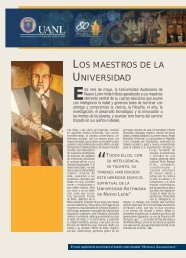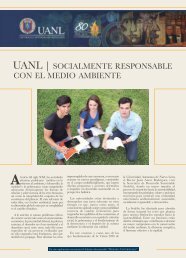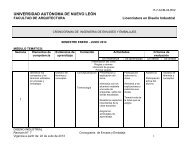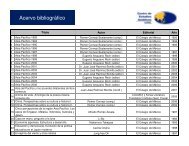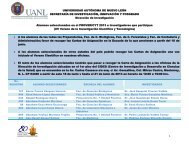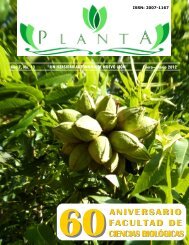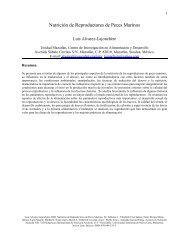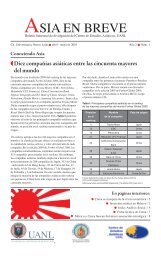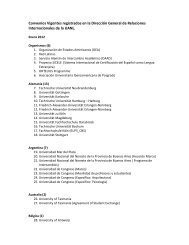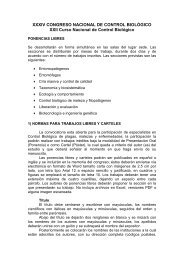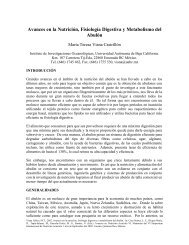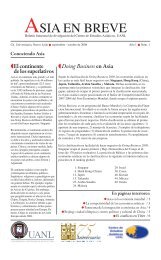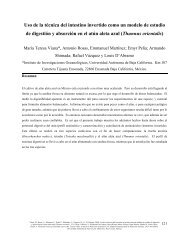Isótopos estables como trazadores nutricionales naturales en larvas ...
Isótopos estables como trazadores nutricionales naturales en larvas ...
Isótopos estables como trazadores nutricionales naturales en larvas ...
You also want an ePaper? Increase the reach of your titles
YUMPU automatically turns print PDFs into web optimized ePapers that Google loves.
664<br />
Fitzsimons, J.M. (eds.), Biology of Hawaiian Streams and Estuaries. Bishop Museum Bulletin in<br />
Cultural and Environm<strong>en</strong>tal Studies, Honolulu, Hawaii.<br />
Hobson K.A., Clark R.G. (1992) Assessing avian diets using stable isotopes 1: turnover of 13 C in tissues.<br />
Condor 94, 181–188.<br />
Houlihan D.F., Carter C.G., McCarthy I.D. (1995) Protein turnover in animals. Chapter 1. In: Nitrog<strong>en</strong><br />
metabolism and excretion. (ed. by Walsh, P.J. and Wright, P.). CRC Press. Boca Raton, FL,<br />
USA. pp. 1-31.<br />
Houlihan D.F., Hall S.J., Gray C., Noble B.S. (1988) Growth rates and protein turnover in Atlantic cod,<br />
Gadus morhua. Canadian Journal of Fisheries and Aquatic Sci<strong>en</strong>ces 45, 951-964.<br />
Jardine T.D. MacLatchy D.L., Fairchild W.L., Cunjak, R.A., Brown, S.B. (2004) Rapid carbon turnover<br />
during growth of Atlantic salmon (Salmo salar) smolts in seawater, and evid<strong>en</strong>ce of food<br />
consumption by growth-stunts. Hydrobiologia 527, 63–75.<br />
Jomori R.K., Ducatti C., Carneiro D.J., Portella M.C. (2008) Stable carbon (δ 13 C) and nitrog<strong>en</strong> (δ 15 N)<br />
isotopes as natural indicators of live and dry food in Piaractus mesopotamicus (Holmberg, 1887)<br />
larval tissue. Aquaculture Research 39, 370–381.<br />
Le Vay L., Gamboa-Delgado J. (2010) Naturally-occurring stable isotopes as direct measures of larval<br />
feeding effici<strong>en</strong>cy, nutri<strong>en</strong>t incorporation and turnover. Aquaculture. In press.<br />
doi:10.1016/j.aquaculture.2010.03.033<br />
Lindholm M., Hess<strong>en</strong> D.O. (2007) Zooplankton succession on seasonal floodplains: surfing on a wave of<br />
food. Hydrobiologia 592, 95-104.<br />
Liu H., Kelly M.S., Cook E.J., Black K.D., Orr H., Zhu J.X., Dong S.L. (2007) The effect of diet type on<br />
growth and fatty acid composition of sea urchin larvae, I. Parac<strong>en</strong>trotus lividus (Lamarck, 1816)<br />
(Echinodermata). Aquaculture 265, 247–262.<br />
MacAvoy S.E., Arneson L.S., Bassett E. (2006) Correlation of metabolism with tissue carbon and<br />
nitrog<strong>en</strong> turnover rate in small mammals. Oecologia 150, 190 – 201.<br />
MacAvoy S.E., Macko S.A., Arneson L.S. (2005) Growth versus metabolic tissue replacem<strong>en</strong>t in mouse<br />
tissues determined by stable carbon and nitrog<strong>en</strong> isotope analysis. Canadian Journal of Zoology<br />
83, 631–641.<br />
McClelland J.W., Montoya J.P. (2002) Trophic relationships and the nitrog<strong>en</strong> isotopic composition of<br />
amino acids in plankton. Ecology 83, 2173-2180.<br />
McCullagh J., Gaye-Siessegger J., Fock<strong>en</strong> U. (2008) Determination of underivatized amino acid δ 13 C by<br />
liquid chromatography/isotope ratio mass spectrometry for nutritional studies: the effect of<br />
dietary non-ess<strong>en</strong>tial amino acid profile on the isotopic signature of individual amino acids in<br />
fish. Rapid Communications in Mass Spectrometry 22, 1817-1822.<br />
Martínez del Rio C., Wolf N., Carleton S.A., Gannes, L.Z. (2009) Isotopic ecology t<strong>en</strong> years after a call<br />
for more laboratory experim<strong>en</strong>ts. Biology Reviews 84, 91-111.<br />
Martínez del Rio C., Wolf B.O. (2005) Mass-balance models for animal isotopic ecology. In:<br />
Physiological and ecological adaptations to feeding in vertebrates. (ed. by Starck, J.M., Wang.<br />
T.). Sci<strong>en</strong>ce Publishers, Enfield, NH, pp. 141-174.<br />
Gamboa-Delgado, J. 2010. <strong>Isótopos</strong> <strong>estables</strong> <strong>como</strong> <strong>trazadores</strong> <strong>nutricionales</strong> <strong>naturales</strong> <strong>en</strong> <strong>larvas</strong> y juv<strong>en</strong>iles de Litop<strong>en</strong>aeus vannamei y Solea<br />
s<strong>en</strong>egal<strong>en</strong>sis. En: Cruz-Suarez, L.E., Ricque-Marie, D., Tapia-Salazar, ., Nieto-López, M.G., Villarreal-Cavazos, D. A., Gamboa-Delgado, J. (Eds),<br />
Avances <strong>en</strong> Nutrición Acuícola X - Memorias del X Simposio Internacional de Nutrición Acuícola, 8-10 de Noviembre, San Nicolás de los<br />
Garza, N. L., México. ISBN 978-607-433-546-0.Universidad Autónoma de Nuevo León, Monterrey, México, pp. 620-667.



